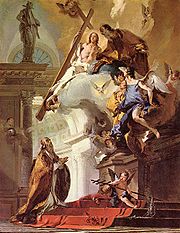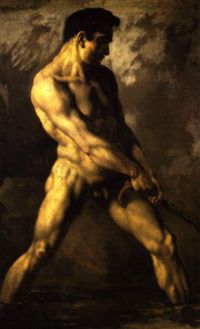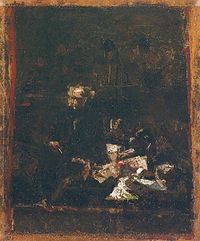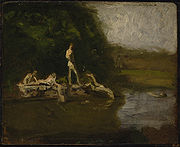
Oil sketch
Encyclopedia

Oil paint
Oil paint is a type of slow-drying paint that consists of particles of pigment suspended in a drying oil, commonly linseed oil. The viscosity of the paint may be modified by the addition of a solvent such as turpentine or white spirit, and varnish may be added to increase the glossiness of the...
s that is more abbreviated in handling than a fully finished painting. Originally these were created as preparatory studies or modelli
Modello
A modello, from the Italian, is a preparatory study or model, usually at a smaller scale, for a work of art or architecture, especially one produced for the approval of the commissioning patron. The term gained currency in art circles in Tuscany in the fourteenth century. Modern definitions in...
, especially so as to gain approval for the design of a larger commissioned painting. They were also used as designs for specialists in other media, such as printmaking
Printmaking
Printmaking is the process of making artworks by printing, normally on paper. Printmaking normally covers only the process of creating prints with an element of originality, rather than just being a photographic reproduction of a painting. Except in the case of monotyping, the process is capable...
or tapestry
Tapestry
Tapestry is a form of textile art, traditionally woven on a vertical loom, however it can also be woven on a floor loom as well. It is composed of two sets of interlaced threads, those running parallel to the length and those parallel to the width ; the warp threads are set up under tension on a...
, to follow. Later they were produced as independent works, often with no thought of being expanded into a full-size painting.
The usual medium
Sketch (drawing)
A sketch is a rapidly executed freehand drawing that is not usually intended as a finished work...
for modelli was the drawing
Drawing
Drawing is a form of visual art that makes use of any number of drawing instruments to mark a two-dimensional medium. Common instruments include graphite pencils, pen and ink, inked brushes, wax color pencils, crayons, charcoal, chalk, pastels, markers, styluses, and various metals .An artist who...
, but an oil sketch, even if done in a limited range of colours, could better suggest the tone of the projected work. It is also possible to more fully convey the flow and energy of a composition in paint. For a painter with exceptional technique, the production of an oil sketch may be as rapid as that of a drawing, and many practitioners had superb brush skills. In its rapidity of execution the oil sketch may be used not only to express movement and transient effects of light and color, its gestural nature may even represent a mimetic parallel to the action of the subject.
One of the earliest artists to produce oil sketches was Polidoro da Caravaggio, a fine draftsman and pupil of Raphael
Raphael
Raffaello Sanzio da Urbino , better known simply as Raphael, was an Italian painter and architect of the High Renaissance. His work is admired for its clarity of form and ease of composition and for its visual achievement of the Neoplatonic ideal of human grandeur...
, but not one who had passed through the traditional Florentine training, with its emphasis on drawing. His are all apparently related to works later done on a larger scale, and are themselves relatively large and on panel
Panel painting
A panel painting is a painting made on a flat panel made of wood, either a single piece, or a number of pieces joined together. Until canvas became the more popular support medium in the 16th century, it was the normal form of support for a painting not on a wall or vellum, which was used for...
, with examples in the National Gallery, London
National Gallery, London
The National Gallery is an art museum on Trafalgar Square, London, United Kingdom. Founded in 1824, it houses a collection of over 2,300 paintings dating from the mid-13th century to 1900. The gallery is an exempt charity, and a non-departmental public body of the Department for Culture, Media...
http://www.nationalgallery.org.uk/cgi-bin/WebObjects.dll/CollectionPublisher.woa/wa/work?workNumber=NG6594 and Courtauld Institute of Art
Courtauld Institute of Art
The Courtauld Institute of Art is a self-governing college of the University of London specialising in the study of the history of art. The Courtauld is one of the premier centres for the teaching of art history in the world; it was the only History of Art department in the UK to be awarded a top...
being 75 and 65 cm tall respectively. Sometimes a number of sketches for the same composition have survived.

Anthony van Dyck
Sir Anthony van Dyck was a Flemish Baroque artist who became the leading court painter in England. He is most famous for his portraits of Charles I of England and his family and court, painted with a relaxed elegance that was to be the dominant influence on English portrait-painting for the next...
, who did not use oil sketches for the portraits that were the bulk of his output, but did for his print
Old master print
An old master print is a work of art produced by a printing process within the Western tradition . A date of about 1830 is usually taken as marking the end of the period whose prints are covered by this term. The main techniques concerned are woodcut, engraving and etching, although there are...
series the Iconographie, and for other works such as a projected series of tapestries and some religious paintings.
Perhaps the first to produce oil sketches as independent works was Giovanni Benedetto Castiglione
Giovanni Benedetto Castiglione
Giovanni Benedetto Castiglione was an Italian Baroque artist, painter, printmaker and draftsman, of the Genoese school. He is best known now for his elaborate engravings, and as the inventor of the printmaking technique of monotyping. He was known as Il Grechetto in Italy and in France as Le...
, an amazingly fecund generator of compositions on a relatively small range of subjects. He grew up and trained in Genoa
Genoa
Genoa |Ligurian]] Zena ; Latin and, archaically, English Genua) is a city and an important seaport in northern Italy, the capital of the Province of Genoa and of the region of Liguria....
, and apparently had contact with both Rubens and Van Dyck during their stays there. He produced a large number of small works, mostly on paper, in a mixture of mediums - drawings or gouache
Gouache
Gouache[p], also spelled guache, the name of which derives from the Italian guazzo, water paint, splash or bodycolor is a type of paint consisting of pigment suspended in water. A binding agent, usually gum arabic, is also present, just as in watercolor...
s finished in oil, oils with pen details - in fact, most possible permutations. Detail is typically restricted to a few key points, with much of the subject conveyed in impressionistic fashion. By this time a collectors' market for studies in drawing was well developed, and there was appreciation of their energy and freedom. Castiglione's sketches to some extent seem to trade off this appreciation, and look more unfinished and offhand than they actually are - a concept with a great future.
A systematic producer of small modelli sketches on canvas with a high degree of finish was the 18th century Venetian
Venice
Venice is a city in northern Italy which is renowned for the beauty of its setting, its architecture and its artworks. It is the capital of the Veneto region...
Giovanni Battista Tiepolo
Giovanni Battista Tiepolo
Giovanni Battista Tiepolo , also known as Gianbattista or Giambattista Tiepolo, was an Italian painter and printmaker from the Republic of Venice...
, whose superb technique is often shown at its best in reducing a huge altarpiece
Altarpiece
An altarpiece is a picture or relief representing a religious subject and suspended in a frame behind the altar of a church. The altarpiece is often made up of two or more separate panels created using a technique known as panel painting. It is then called a diptych, triptych or polyptych for two,...
to a lively but precise rendering at this small scale. At roughly the same time Jean Fragonard was producing a series of virtuosic Figures de fantaisie, half-length portraits of imaginary subjects, purporting to have been painted in an hour.

John Constable
John Constable
John Constable was an English Romantic painter. Born in Suffolk, he is known principally for his landscape paintings of Dedham Vale, the area surrounding his home—now known as "Constable Country"—which he invested with an intensity of affection...
made extensive use of sketches for his landscapes, both of intimate scale, often in a sketchbook
Sketchbook
A sketchbook is "a book or pad with blank pages for sketching," and is frequently used by artists for drawing or painting as a part of their creative process....
on paper, and in full-scale sketches for his largest "six-footers", which he used to refine his compositions.


Eugène Delacroix
Ferdinand Victor Eugène Delacroix was a French Romantic artist regarded from the outset of his career as the leader of the French Romantic school...
, Géricault, Manet
Édouard Manet
Édouard Manet was a French painter. One of the first 19th-century artists to approach modern-life subjects, he was a pivotal figure in the transition from Realism to Impressionism....
and Degas are other artists who often used them. For some oil sketches Degas painted in essence, a technique by which the oil had been all but removed from the pigment, so that the artist was virtually drawing with pure paint. Seurat made many careful small oil sketches for his larger works. However, with the advent of Impressionism
Impressionism
Impressionism was a 19th-century art movement that originated with a group of Paris-based artists whose independent exhibitions brought them to prominence during the 1870s and 1880s...
, and then Modernism
Modernism
Modernism, in its broadest definition, is modern thought, character, or practice. More specifically, the term describes the modernist movement, its set of cultural tendencies and array of associated cultural movements, originally arising from wide-scale and far-reaching changes to Western society...
, the practice of preparatory drawing and painting tended to decline. The abandonment by many artists of a high level of detail and finish in favor of a more painterly
Painterly
Painterliness is a translation of the German term , a word popularized by Swiss art historian Heinrich Wölfflin in order to help focus, enrich and standardize the terms being used by art historians of his time to characterize works of art...
and spontaneous approach, reduced the distinction between a detailed sketch and a finished painting. Sketches by Rubens or Tiepolo, for example, are at least as highly finished as many 20th century oil paintings. Many artists, especially those working in more traditional styles, still use oil sketches today. Francis Bacon
Francis Bacon (painter)
Francis Bacon , was an Irish-born British figurative painter known for his bold, austere, graphic and emotionally raw imagery. Bacon's painterly but abstract figures typically appear isolated in glass or steel geometrical cages set against flat, nondescript backgrounds...
is an example of an artist who called many of his most important, and largest, finished works "studies": examples are his Three Studies for Figures at the Base of a Crucifixion
Three Studies for Figures at the Base of a Crucifixion
Three Studies for Figures at the Base of a Crucifixion is a 1944 triptych painted by the Irish-born artist Francis Bacon. The work is based on the Eumenides—or Furies—of Aeschylus' The Oresteia, and depicts three writhing anthropomorphic creatures set against a flat burnt orange background...
Tate Britain
Tate Britain
Tate Britain is an art gallery situated on Millbank in London, and part of the Tate gallery network in Britain, with Tate Modern, Tate Liverpool and Tate St Ives. It is the oldest gallery in the network, opening in 1897. It houses a substantial collection of the works of J. M. W. Turner.-History:It...
, or his Study from Pope Innocent X, auctioned in 2007 for $52.7 million.

